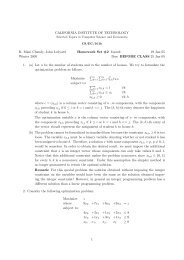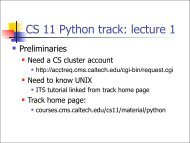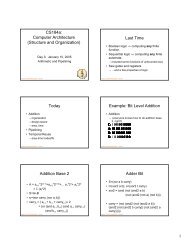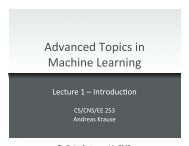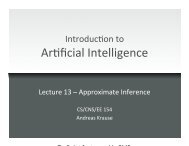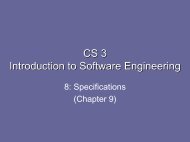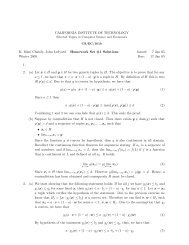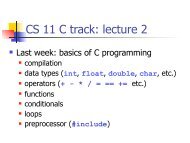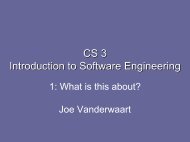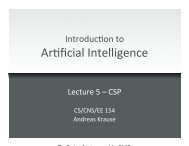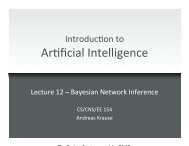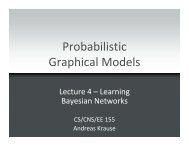Homework 3 Solutions - Caltech
Homework 3 Solutions - Caltech
Homework 3 Solutions - Caltech
Create successful ePaper yourself
Turn your PDF publications into a flip-book with our unique Google optimized e-Paper software.
CALIFORNIA INSTITUTE OF TECHNOLOGY<br />
Selected Topics in Computer Science and Economics<br />
CS/EC/101b<br />
K. Mani Chandy, John Ledyard <strong>Homework</strong> Set #3 Issued: 19 Jan 05<br />
Winter 2005 Due: BEFORE CLASS 25 Jan 05<br />
1. (a) Tree for this game<br />
I<br />
A B<br />
C D<br />
II<br />
II<br />
II<br />
II<br />
B<br />
C<br />
D<br />
A<br />
C<br />
D<br />
A<br />
B<br />
D<br />
A<br />
B<br />
C<br />
III<br />
III III III III III<br />
III<br />
III<br />
III<br />
III<br />
III<br />
III<br />
C<br />
D<br />
B<br />
D<br />
B<br />
C<br />
C D A D A C<br />
B<br />
D<br />
A<br />
D<br />
A<br />
B<br />
B<br />
C<br />
A<br />
C<br />
A<br />
B<br />
D<br />
C<br />
D<br />
B<br />
C<br />
B<br />
D C D A C A<br />
D<br />
B<br />
D<br />
A<br />
B<br />
A<br />
C<br />
B<br />
C<br />
A<br />
B<br />
A<br />
Figure 1: Tree for the game in exercise 1(a)<br />
(b) (a) Player 1 has 4 strategies.<br />
(b) Player 2 has 3 4 strategies.<br />
(c) Player 3 has 2 12 strategies.<br />
(c) We use the mechanism of backward induction to decide that, as follows. The arrow<br />
denotes that the player vetoes the candidate who labels the edge, see Figure 2.<br />
The conclusion is that C wins if a subgame perfect equilibrium is used.<br />
A subgame perfect equilibrium is the following:<br />
I: A<br />
II: (B, A, A, A)<br />
III: (D, B, B, D, A, A, B, A, B, B, A, B)<br />
(d) Consider the following subgame:<br />
I: D<br />
1
I<br />
A B<br />
C D<br />
C<br />
II<br />
C<br />
II<br />
D<br />
II<br />
C<br />
II<br />
B<br />
C<br />
D<br />
A<br />
C<br />
D<br />
A<br />
B<br />
D<br />
A<br />
B<br />
C<br />
C<br />
III D III C III C III D III C III D III D III A III C III C III A III<br />
C<br />
D<br />
B<br />
D<br />
B<br />
C<br />
C D A D A C<br />
B<br />
D<br />
A<br />
D<br />
A<br />
B<br />
B<br />
C<br />
A<br />
C<br />
A<br />
B<br />
D<br />
C<br />
D<br />
B<br />
C<br />
B<br />
D C D A C A<br />
D<br />
B<br />
D<br />
A<br />
B<br />
A<br />
C<br />
B<br />
C<br />
A<br />
B<br />
A<br />
Figure 2: Tree for the game in exercise 1(c)<br />
II: (C, A, B, A)<br />
III: (D, B, B, D, A, A, B, A, B, B, A, B)<br />
This is clearly not a subgame perfect equlibrium. In fact, if player 1 would play A, then<br />
player 2 would play C and player 3 would play B. So, the final outcome would be D.<br />
A better move for player 2 would have been to play D instead of C. In fact, knowing<br />
that player 3 would have played B, this would have given an outcome of C.<br />
2. (a) See Figure 3, where (i, j) is such that i denotes the money of player 1 and j denotes the<br />
money of player 2.<br />
(b) She will not find the incumbent monopolist credible because fighting will be worse than<br />
acquiescencing for player 1.<br />
(c) If they both act rationally, then the following game will be played:<br />
3. (a) See Figure 4<br />
- Since player 2 thinks that player 1 acts rationaly, then player 2 will enter the market<br />
because he would get more then staying out and player 1 will act rationally, which<br />
means that he will acquiesce. In fact, if he acquiesces the outcome for player 1 will<br />
be better then if he decides to fight. The conclusion, if they both act rationally, then:<br />
- player 1 acquiesces<br />
- player 2 enters the market.<br />
2
Player 2<br />
enter<br />
out<br />
Player 1<br />
(5, 1)<br />
fight<br />
acquiesce<br />
(0, 0) (2, 2)<br />
Figure 3: Tree for the game in Exercise 2(a)<br />
(b) Applying backward induction get we obtain the tree in Figure 5. The arrow in the tree<br />
indicates the choice of the player, the outcome for a given choice is represented by a<br />
pair (a, b) inside the circle. It clearly appears that there is only one subgame perfect<br />
equilibrium which is given by<br />
I: invest<br />
II: (out, enter)<br />
III: (−, fight, −, acquiesce)<br />
The symbol − denotes the absence of action.<br />
(c) A game theorist might replay that investing is like an irreversible commitment for player<br />
1. Player 2 now knows that player 1 would be better off fighting than acquiescencing if<br />
he enters the market. So it would be better for player 2 to stay out of the market and<br />
get an outcome of 1 rather than entering the market and getting an outcome of 0.<br />
player 2 is that player 2 is rational. In this case when player 2 is not rational, then he<br />
might choose to enter the market and then it makes sense for player 1 to fight.<br />
4. (a) Yes, (1, 1, 1) is such a strategy profile. Suppose we have the profile (1, 1, 1). If player i<br />
increases his number to x > 1, then he will have a smaller gain for the following reason.<br />
The fraction 2 3 of the average is: ( )<br />
2 1 + 1 + x<br />
3 3<br />
= 4 + 2x<br />
9<br />
(1)<br />
3
Player 1<br />
invest<br />
not invest<br />
Player 2<br />
Player 2<br />
out enter out enter<br />
(3, 1)<br />
Player 1<br />
(5, 1)<br />
Player 1<br />
acquiesce<br />
fight<br />
acquiesce<br />
fight<br />
(0, 2)<br />
(1, 0)<br />
(2, 2) (0, 0)<br />
Figure 4: Tree for the game in Exercise 3(a)<br />
It is easy to check that the absolute value of the difference |1 − 2x−5<br />
9<br />
| is smaller than the<br />
absolute value of the difference |1 − 7x−4<br />
9<br />
| for any x > 1. Hence, player 1 will be farther<br />
than any other player from the expression in equation 1. The conclusion is that 1, 1, 1 is<br />
a Nash equilibrium.<br />
(b) No, there is no other profile which is a Nash equilibrium. We will prove the stronger<br />
statement that (1, 1, 1) is the unique Nash equilibrium of the game. We start proving<br />
that (h, g, k), is not a Nash equilibrium whenever the three numbers are not the same.<br />
This will imply that if there is a Nash equilibrium, it must be of the form (k, k, k) for some<br />
positive k ≥ 1. Suppose by contradiction that this is not true and let v = max{h, g, k}<br />
be the number played by Player 1. This can be done without loss of generality since the<br />
proof is symmetric for every player. It is obvious that Player 1 will not get any money<br />
since there will be at least another player who is closer than him to 2 3<br />
of the average. Let<br />
him be Player 2 and let q be the number he has chosen. Suppose now that Player 1 moves<br />
his choice to q. Then his outcome will certainly be greater than 0 (he will certainly split<br />
the money with Player 2 and possibly with Player 3). The conclusion is that (h, g, k) can<br />
not be a Nash equilibrium. So far, we have proven that any Nash equilibrium will be of<br />
the form (k, k, k), for k ≥ 1. The last part of the proof shows that the only possibility<br />
for a Nash equilibrium is (k, k, k) = (1, 1, 1). Suppose by contradiction that (k, k, k) for<br />
k ≥ 2 is a Nash equilibrium. If player i moves his choice to 1, while the other players do<br />
not change their choices, then player i will be the only player to get the outcome, i.e. he<br />
will not have to split it with anyone else. For that we need to show that the inequality 2<br />
4
Player 1<br />
(3, 1)<br />
invest<br />
not invest<br />
Player 2<br />
(3, 1)<br />
Player 2<br />
(2, 2)<br />
out enter out enter<br />
(3, 1)<br />
Player 1<br />
(1, 0)<br />
(5, 1)<br />
Player 1<br />
(2, 2)<br />
acquiesce<br />
fight<br />
acquiesce<br />
fight<br />
(0, 2)<br />
(1, 0)<br />
(2, 2) (0, 0)<br />
Figure 5: Tree for the game in Exercise 3(b)<br />
holds:<br />
Inequality 2 is true iff<br />
∣ 1 − 2 ( )∣ ( )∣ 2k + 1 ∣∣∣ <<br />
2k + 1 ∣∣∣<br />
3 3 ∣ k − 2 (2)<br />
9<br />
( ∣( )∣ 9 − 4k − 2<br />
∣∣∣<br />
∣<br />
)<br />
5k − 2 ∣∣∣<br />
9 ∣ < (3)<br />
9<br />
It can be checked that the above expression is always true for any k > 1 (take the square<br />
of the left hand side and the right hand side to verify it).<br />
The overall conclusion is that (1, 1, 1) is the only Nash equilibrium of the game.<br />
(c) The only rationalizable strategy for each player is to play 1.<br />
Proof. Let s be the number played by Player 1. Consider the function<br />
∣ s − 2 3<br />
s + h + k<br />
3<br />
∣ (4)<br />
Fixing h and k, we have that this function is increasing for s ≥ (h + k)/7. Consequently,<br />
player 1 will never play more than (K + K)/7, where K is the largest number which can<br />
K+K<br />
K+ 7<br />
be used. Then, player 2 will not play anything bigger than<br />
7<br />
. We can continue<br />
iterating in this way until we get that no player will ever use a number l, l > 1. This<br />
proves that (1, 1, 1) is the only rationalizable strategy.<br />
5



